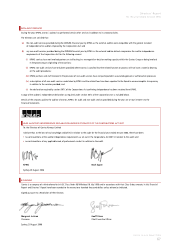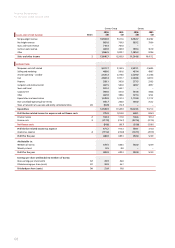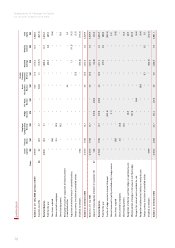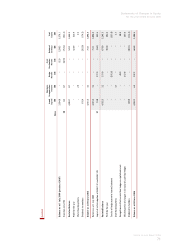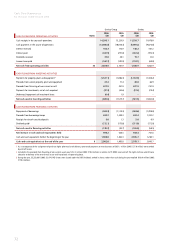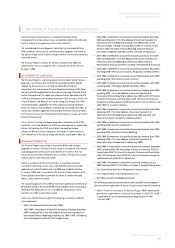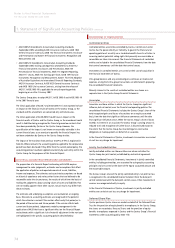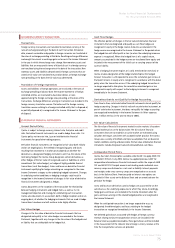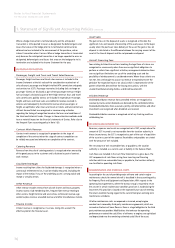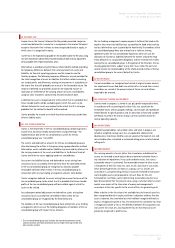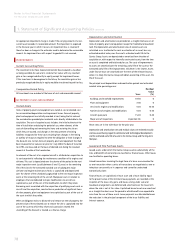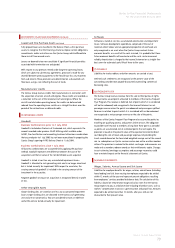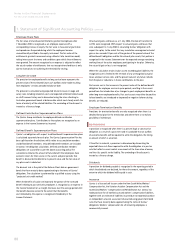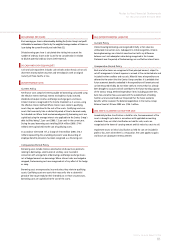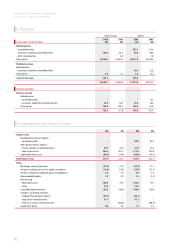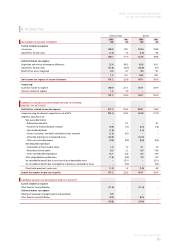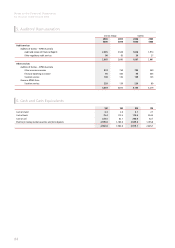Qantas 2006 Annual Report Download - page 76
Download and view the complete annual report
Please find page 76 of the 2006 Qantas annual report below. You can navigate through the pages in the report by either clicking on the pages listed below, or by using the keyword search tool below to find specific information within the annual report.
74
Notes to the Financial Statements
for the year ended 30 June 2006
• AASB 2005-9 Amendments to Australian Accounting Standards
(September 2005) amending AASB 4 Insurance Contracts, AASB 1023
General Insurance Contracts, AASB 132 Financial Instruments: Disclosure
and Presentation and AASB 139 Financial Instruments: Recognition and
Measurement; and
• AASB 2005-10 Amendments to Australian Accounting Standards
(September 2005) making consequential amendments to AASB 132
Financial Instruments: Disclosures and Presentation, AASB 101
Presentation of Financial Statements, AASB 114 Segment Reporting,
AASB 117 Leases, AASB 133 Earnings per Share, AASB 139 Financial
Instruments: Recognition and Measurement, AASB 1 First-time Adoption
of Australian Equivalents to International Financial Reporting Standards,
AASB 4 Insurance Contracts, AASB 1023 General Insurance Contracts
and AASB 1038 Life Insurance Contracts, arising from the release of
AASB 7. AASB 2005-10 is applicable for annual reporting periods
beginning on or after 1 January 2007.
The Qantas Group plans to adopt AASB 7, AASB 2005-9 and AASB 2005-10
in the 2007 financial year.
The initial application of AASB 7 and AASB 2005-10 is not expected to have
an impact on the financial results of Qantas or the Qantas Group, as the
standard and the amendment are concerned only with disclosures.
The initial application of AASB 2005-9 could have an impact on the
financial results of Qantas and the Qantas Group, as the amendment could
result in liabilities being recognised for financial guarantee contracts that
have been provided by Qantas or the Qantas Group. However, the
quantification of the impact is not known or reasonably estimable in the
current financial year, as an exercise to quantify the financial impact has
not been undertaken by Qantas or the Qantas Group to date.
The impact of the transition from previous GAAP to A-IFRS is explained in
Note 36. Where relevant, the accounting policies applied to the comparative
period have been disclosed if they differ from the current period policy. The
accounting policies have been applied consistently by each entity within the
Qantas Group for the purposes of this Financial Report.
(C) CRITICAL ACCOUNTING ESTIMATES AND JUDGEMENTS
The preparation of a Financial Report conforming with AASB requires
management to make judgements, estimates and assumptions that affect
the application of policies and reported amounts of assets, liabilities,
income and expenses. The estimates and associated assumptions are based
on historical experience and various other factors that are believed to be
reasonable under the circumstances, the results of which form the basis of
making the judgements about carrying values of assets and liabilities that
are not readily apparent from other sources. Actual results may differ from
these estimates.
The estimates and underlying assumptions are reviewed on an ongoing
basis. Revisions to accounting estimates are recognised in the period in
which the estimate is revised if the revision affects only that period, or in
the period of the revision and future periods if the revision affects both
current and future periods. Judgements made by management in the
application of AASB that have a significant effect on the Financial Report
and estimates with a significant risk of material adjustment in the next year
are highlighted in the specific accounting policies detailed below.
(D) PRINCIPLES OF CONSOLIDATION
Controlled entities
Controlled entities are entities controlled by Qantas. Control exists when
Qantas has the power, directly or indirectly, to govern the financial and
operating policies of an entity so as to obtain benefits from its activities. In
assessing control, potential voting rights that presently are exercisable or
convertible are taken into account. The Financial Statements of controlled
entities are included in the consolidated Financial Statements from the date
that control commences until the date that control ceases.
Investments in controlled entities are carried at their cost of acquisition in
the Financial Statements of Qantas.
Intra-group balances and any unrealised gains and losses or income and
expenses arising from intra-group transactions are eliminated in preparing
the consolidated Financial Statements.
Minority interest in the results of controlled entities are shown as a
separate item in the Qantas Group Financial Statements.
Associates
Associates are those entities in which the Qantas Group has significant
influence, but not control, over the financial and operating policies. The
consolidated Financial Statements includes the Qantas Group’s share of the
total recognised gains and losses of associates on an equity accounted
basis, from the date that significant influence commences until the date
that significant influence ceases. When the Qantas Group’s share of losses
exceeds its interest in an associate, the Qantas Group’s carrying amount is
reduced to nil and recognition of further losses is discontinued except to
the extent that the Qantas Group has incurred legal or constructive
obligations or made payments on behalf of an associate.
In the Financial Statements of Qantas, investments in associates are carried
at cost less any charge for impairment.
Jointly Controlled Entities
Jointly controlled entities are those entities over whose activities the
Qantas Group has joint control, established by contractual agreement.
In the consolidated Financial Statements, investments in jointly controlled
entities, including partnerships, are accounted for using equity accounting
principles and are carried at the lower of the equity accounted amount and
the recoverable amount.
The Qantas Group’s share of the jointly controlled entity’s net profit or loss
is recognised in the consolidated Income Statement from the date joint
control commenced until the date joint control ceases. Other movements in
reserves are recognised directly in equity.
In the Financial Statements of Qantas, investments in jointly controlled
entities are carried at cost less any charge for impairment.
Deferred Share Plan
Qantas purchases Qantas shares on market on behalf of the Deferred Share
Trust for the provision of equity benefits to employees. In the Qantas Group,
the shares are recorded as Treasury Shares and the provision of equity
benefits to employees expensed in Qantas and the Qantas Group’s Financial
Statements under accounting policy Note 1(V).
1. Statement of Signifi cant Accounting Policies continued





